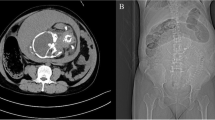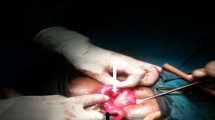Abstract
A 39-year-old previously healthy woman was referred to our emergency department by a primary care doctor on suspected to be acute enteritis, complaining of fever, anorexia, lower abdominal pain, and frequent diarrhea. The day after admission, although frequent diarrhea stopped, the abdominal distension worsened. An abdominal radiograph revealed several dilated loops of the small bowel, suggested that small bowel obstruction (SBO) had developed. White blood cell count and c-reactive protein were markedly increased, and abdominal contrast-enhanced computed tomography scan showed localized severely edematous bowel mucosa, increased adipose tissue concentration in the pelvis, and a beaded low absorption area in the uterus. Gynecological examination revealed the presence of a pus-filled plastic intrauterine device (IUD) in the uterus. The patient confided that she had sex with her husband 2 days before the onset of symptoms. A diagnosis of SBO due to pelvic peritonitis caused by IUD infection during sexual activity was made. The SBO was cleared in 12 days with fasting, peripheral parenteral nutrition, antibiotic treatment, and insertion of an ileus tube. This case reminds us that it needs to consider disorders associated with the uterine appendages, in women of reproductive age with lower abdominal pain.




Similar content being viewed by others
References
Hsia JK, Creinin MD. Intrauterine contraception. Semin Reprod Med. 2016;34:175–82.
Antonelli D, Kustrup JF Jr. Large bowel obstruction due to intrauterine device: associated pelvic inflammatory disease. Am Surg. 1999;65:1165–6.
Brar R, Doddi S, Ramasamy A, et al. A forgotten migrated intrauterine contraceptive device is not always innocent: a case report. Case Rep Med. 2010;2010:740642.
Jones D. Young woman with abdominal pain. Small bowel obstruction caused by IUD migration. Ann Emerg Med. 2014;64:423–5.
Loveless A, Dhari A, Kilpatrick CC. Perforated levonorgestrel-releasing intrauterine system resulting in small bowel obstruction: a case report. J Reprod Med. 2014;59:611–3.
Xu JX, Remedios E, Duthie A, et al. Intrauterine contraceptive device: cause of small bowel obstruction and ischaemia. ANZ J Surg. 2017;87:E319–20.
Nasu K, Matsumoto H, Yoshimatsu J, et al. Ureteral and sigmoid obstruction caused by pelvic actinomycosis in an intrauterine contraceptive device user. Gynecol Obstet Invest. 2002;54:228–31.
Rudensky B, Abramowitz H, Yinnon AM, et al. Intrauterine device as source of pneumococcal intra-abdominal infection and small-bowel obstruction. Eur J Clin Microbiol Infect Dis. 2004;23:576–7.
Horvat M, Kovacic S, Potrc S, et al. Abdominal actinomycosis presenting as a small-bowel obstruction. Wien Klin Wochenschr. 2004;116(Suppl 2):97–9.
Biyani DK, Denley H, Hill J, et al. IUCD induced abdomino-pelvic actinomycosis presenting as acute large bowel obstruction. J Obstet Gynaecol. 2007;27:870–1.
Nozawa H, Yamada Y, Muto Y, et al. Pelvic actinomycosis presenting with a large abscess and bowel stenosis with marked response to conservative treatment: a case report. J Med Case Rep. 2007;1:141.
Sivakumar R, Bhatti I, Bali A, et al. Gynaecological cause for bowel obstruction. Gut. 2009;58(1466):544.
Nissi R, Sequeiros RBB, Lappi-Blanco E, et al. Large bowel obstruction in a young woman simulating a malignant neoplasm: a case report of actinomyces infection. Case Rep Obstet Gynecol. 2013;2013: 756768.
Yang SS, Im YC. Severe abdominopelvic actinomycosis with colon perforation and hepatic involvement mimicking advanced sigmoid colon cancer with hepatic metastasis: a case study. BMC Surg. 2018;18:51.
ten Broek RP, Issa Y, van Santbrink EJ, et al. Burden of adhesions in abdominal and pelvic surgery: systematic review and met-analysis. BMJ. 2013;347:f5588.
Miller G, Boman J, Shrier I, et al. Etiology of small bowel obstruction. Am J Surg. 2000;180:33–6.
Zissin R, Hertz M, Paran H, et al. Small bowel obstruction secondary to Crohn disease: CT findings. Abdom Imaging. 2004;29:320–5.
Idelevich E, Kashtan H, Mavor E, et al. Small bowel obstruction caused by secondary tumors. Surg Oncol. 2006;15:29–32.
Seike T, Yamato M, Suda T, et al. A case of small bowel adenocarcinoma that caused intestinal obstruction after administration of patency capsule. Clin J Gastroenterol. 2020;13:522–6.
Tepper NK, Steenland MW, Gaffield ME, et al. Retention of intrauterine devices in women who acquire pelvic inflammatory disease: a systematic review. Contraception. 2013;87:655–60.
Farley TM, Rosenberg MJ, Rowe PJ, et al. Intrauterine devices and pelvic inflammatory disease: an international perspective. Lancet. 1992;339:785–8.
Campbell SJ, Cropsey KL, Matthews CA. Intrauterine device use in a high-risk population: experience from an urban university clinic. Am J Obstet Gynecol. 2007;197:193.e1-6 (discussion e6–7).
Westhoff C. IUDs and colonization or infection with actinomyces. Contraception. 2007;75:S48-50.
García-García A, Ramírez-Durán N, Sandoval-Trujillo H, et al. Pelvic actinomycosis. Can J Infect Dis Med Microbiol. 2017;2017:9428650.
Laurent T, de Grandi P, Schnyder P. Abdominal actinomycosis associated with intrauterine device: CT features. Eur Radiol. 1996;6:670–3.
Myers LL, Shoop DS, Stackhouse LL, et al. Isolation of enterotoxigenic Bacteroides fragilis from humans with diarrhea. J Clin Microbiol. 1987;25:2330–3.
Keenan JE, Turley RS, McCoy CC, et al. Trials of nonoperative management exceeding 3 days are associated with increased morbidity in patients undergoing surgery for uncomplicated adhesive small bowel obstruction. J Trauma Acute Care Surg. 2014;76:1367–72.
Catena F, Di Saverio S, Kelly MD, et al. Bologna guidelines for diagnosis and management of adhesive small bowel obstruction (ASBO): 2010 evidence-based guidelines of the World Society of Emergency Surgery. World J Emerg Surg. 2011;6:5.
Diaz JJ Jr, Bokhari F, Mowery NT, et al. Guidelines for management of small bowel obstruction. J Trauma. 2008;64:1651–64.
Schraufnagel D, Rajaee S, Millham FH. How many sunsets? Timing of surgery in adhesive small bowel obstruction: a study of the nationwide inpatient sample. J Trauma Acute Care Surg. 2013;74:181–7 (discussion 7–9).
Teixeira PG, Karamanos E, Talving P, et al. Early operation is associated with a survival benefit for patients with adhesive bowel obstruction. Ann Surg. 2013;258:459–65.
Dellinger RP, Levy MM, Rhodes A, et al. Surviving sepsis campaign: international guidelines for management of severe sepsis and septic shock, 2012. Intensive Care Med. 2013;39:165–228.
Acknowledgements
None.
Author information
Authors and Affiliations
Corresponding author
Ethics declarations
Conflict of interest
Authors declare that they have no conflict of interest.
Human/animal rights
All procedures followed have been performed in accordance with the ethical standards laid down in the 1964 Declaration of Helsinki and its later amendments.
Informed consent
Informed consent was obtained from all patients for being included in the study.
Additional information
Publisher's Note
Springer Nature remains neutral with regard to jurisdictional claims in published maps and institutional affiliations.
Rights and permissions
About this article
Cite this article
Seike, T., Kanaya, T., Suda, T. et al. Small bowel obstruction caused by intrauterine device infection. Clin J Gastroenterol 14, 1419–1425 (2021). https://doi.org/10.1007/s12328-021-01476-6
Received:
Accepted:
Published:
Issue Date:
DOI: https://doi.org/10.1007/s12328-021-01476-6




